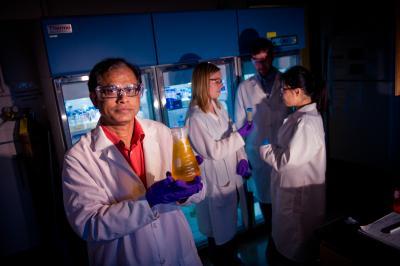A certain type of biomolecule, called a glycoconjugate, is built like a nano-Christmas tree. Its many branches are bedecked with sugary ornaments that get all the glory. That's because, according to conventional wisdom, the glycoconjugate's lowly "tree" basically holds the sugars in place as they do the important work of reacting with other molecules.
A chemist at Michigan Technological University has discovered that the tree itself — the scaffold — is a good deal more than a simple prop.
The discovery opens up new avenues for research, in particular the development of more and better pharmaceuticals. Glycoconjugates are found naturally in the body, but they are also an important class of drugs that includes anything from cancer treatments to vaccines.

Tarun Dam holding a container of lectin, a key component of his team's research. Credit: Michigan Technological University photo by Sarah Bird
"We had always thought that all the biological function resides in the sugar," said Tarun Dam, principal investigator of the Mechanistic Glycobiology Lab at Michigan Tech. "People didn't appreciate that the scaffolds were active."
To determine if the scaffold had a role to play in biological reactions, Dam and his team built and tested two types of glycoconjugate molecules. They had the same sugars and virtually identical shapes but were comprised of different scaffolds, one made of protein, the other a synthetic.
The scientists then tested how the different glycoconjugates reacted with biomolecules called lectins. Lectins play an important role in numerous biological processes and are a target for many glycoconjugate drugs.
If the scaffolds had been inert, the reactions would have been identical. However, the sugars on the protein scaffold reacted with the lectins differently.
"If the scaffolds are different, they can cause my drug to work one way and your drug to work another way, even though they have similar epitopes [sugars]," Dam said. "Tweaking the scaffold can change the drug's function."





Comments